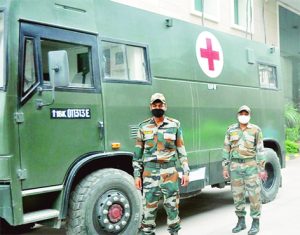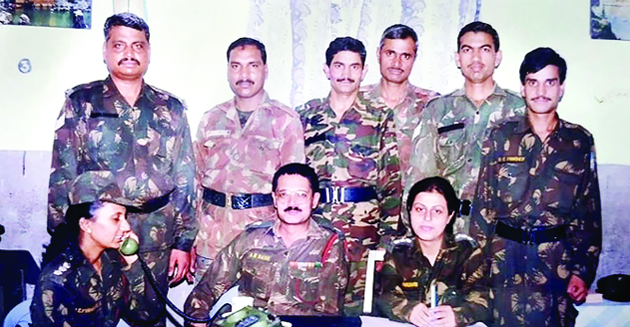Dr Kartikye Singh Lalotra
‘An army marches on its stomach’- Napoleon Bonaparte.
There is an old adage, often attributed to Napoleon Bonaparte that ‘an army marches on its stomach’ meaning a force can only go so far as its logistics allow. If you don’t keep your force fed and supplied, they are unable to proceed further. The great French General extended the operational reach of his forces through the adoption of foraging —units would hunt for food, or take it from conquered towns -often with mixed results. Same thing with their supplies, they fabricated/ improvised what they could and took what they could.
 Even today the laws of armed combat have the same template of pillaging and plundering riding high on the adrenaline so shot in their very sinews by the sight and smell of approaching victory. In our case with the Indian army operating in a similarly disaggregated and dispersed manner as found obtained during Napoleonic era will still require supplies, often over incredibly long ranges. On the occasion of silver jubilee of ‘OP VIJAY’, I in my own little way thought of penning a short write up to just shore up some support for these unsung heroes guiding the trail of logistics but for whom the victory on the icy heights would have been next to impossible. My article would generally confine to the realm of few instances of valour and sheer physically impossible daunting tasks that were accomplished with great aplomb and dedication by the supporting staff alongside the main combatants viz the army doctors attached with the assaulting troops, the various cooks / carpenters and even the animal transport such as mules and donkeys who doubled up to take on tasks that were proverbially going beyond their remit.
Even today the laws of armed combat have the same template of pillaging and plundering riding high on the adrenaline so shot in their very sinews by the sight and smell of approaching victory. In our case with the Indian army operating in a similarly disaggregated and dispersed manner as found obtained during Napoleonic era will still require supplies, often over incredibly long ranges. On the occasion of silver jubilee of ‘OP VIJAY’, I in my own little way thought of penning a short write up to just shore up some support for these unsung heroes guiding the trail of logistics but for whom the victory on the icy heights would have been next to impossible. My article would generally confine to the realm of few instances of valour and sheer physically impossible daunting tasks that were accomplished with great aplomb and dedication by the supporting staff alongside the main combatants viz the army doctors attached with the assaulting troops, the various cooks / carpenters and even the animal transport such as mules and donkeys who doubled up to take on tasks that were proverbially going beyond their remit.
The first such case that comes to my mind belongs to unwavering resolve on the part of the unit cook and carpenter Uttam singh of 2 Raj Rif with the latter unable to see during night time volunteering to take ammunition and supplies by holding the man in front as guide to help him prevent slipping from the mountainside. So did the unit cook who in the line of action received a splinter in his chest and was later shifted to the army hospital. Since I myself belong to the medical fraternity, I would reserve more space in this article of mine for these professionals who were like men possessed during those fateful days of OP VIJAY and did the unthinkable on the battlefield. Take for example the case of Col Vijay kumar who being the doctor attached with an infantry unit in Dras was first hand witness to the horrors of war while moving up towards the LoC on 27 th May 1999. As per him a military hospital provides a stable environment and a doctor is adequately equipped too. But over here in a rugged terrain of high altitude with no cover especially under heavy enemy fire he used to manage casualties inside temporary bunkers or even behind big boulders and rocks with no place to even hang the saline bottles. Same was the case with Col Rajesh Adhau who though from a total civilian background before coming to the army and getting posted to the army RR hospital at Delhi cantt after commissioning thought it would be his final place of working in a class ‘A’ city. Never ever realizing that it was the wont of young medical doctors in the armed forces to provide succor to the fighting troops on the frontline. Even Col VV Sharma another medic during those fateful days of OP VIJAY echoes the same sentiments. As per the version of Col Sharma, war scene is dreadful full of casualties and of an impending doom . That is natural, but then as they say ‘Courage is to hold on a minute longer’ and the true gallantry , valour and zeal to defeat the enemy was far more motivating than the war scene and its after effects’–unquote. Such prophetic words can only be mouthed by someone who has been baptized under the anvil of enemy fire. As per him by moving close with the assaulting troops and establishing field medical camps in close proximity to the place of action, he could save about 150 casualties. That is what is called ‘medical intervention’ in the so called proverbial ‘Golden hour’ after injury when the pendulum of a soldier’s life goes from hope to despair and back to hope. The premonition of death in the war has been very aptly encapsulated by Col Sharma when he says that when he was at the famed ‘Tololing complex’ one of the Jawan from the mess staff who had recently got married was stationed at this complex. On his asking the mess jawan as to why was he over here since he should have been at the administrative base, the stoic reply given to him by the mess jawan was —‘Sir fighting the enemy is my final dharma. I have to fight against the enemy’. Unfortunately after two hours he received a call informing him and saying the brave man was the first casualty of the unit when he got a direct hit on his forehead.
Then there are more riveting tales of even the ‘beasts of burden’ the mules & donkeys doing their bit in this high altitude war as if their animal instincts had been all the more primed to pitch in with all their might to help defeat a treacherous enemy across the LC. The case of mules & donkeys ferrying arms and ammunition and supplies to the forward most troops under intense enemy bombardment everyone has heard and read too in the fabled war accounts of WW1 as well as WWII including the wars that India has fought since 1947 both with its arch enemies viz China & Pakistan. But over here in 1999 a typical case of ferrying the entire paraphernalia of a computer work station to include the computer monitors, CPU, plus generators and accompanying diesel drums for its power generation was enacted just to take out the war citations of the fighting soldiers of 1/11 GR on a donkey train oblivious to the falling enemy shells as well as the time and distance involved from ‘Nurla’ near Leh to ‘Dah’ and subsequently to Yaldor where the unit had to erect a water proof shelter to house this computer God. All this mumbo -jumbo was taken out to adhere higher headquarters directive of writing these citations in a particular format that too in word star IV and data part in D Base III plus. Imagine all this computer jargon amidst a raging war when one is not too sure of seeing the next day’s dawn breaking on the horizon. Now this is what is called as a perfect symphony of cacophonies of war and peace. Both cacophonies ring true to their own calling. There are numerous such war stories of this high altitude war which are written by eminent military historians and such like people to be ruminated at leisure and draw lessons from. Mine was a small maiden attempt on such a solemn occasion (silver jubilee) from the pages of ‘Daily excelsior’ which I am sure will be liked by the readers of this column.
(The writer is a medical professional.)


